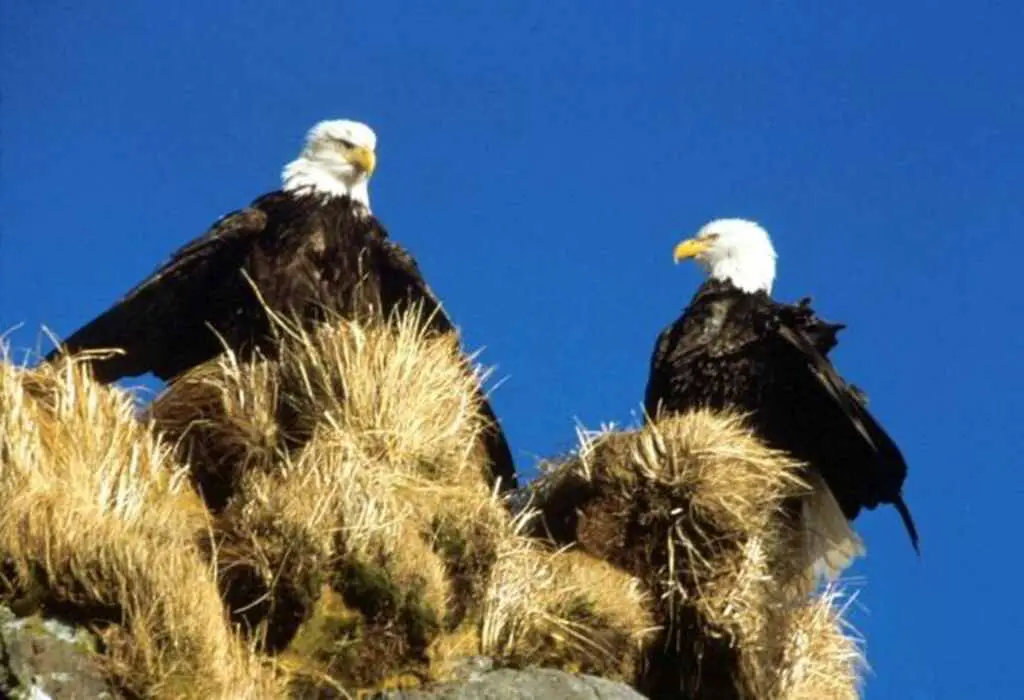How Do Eagles Court? The captivating world of eagle romance is as intriguing as it is majestic. From swooping aerial displays to extravagant gifts, these regal birds have their own unique way of wooing their potential mates.
Curious to discover the secrets of eagle courtship? Join us on a whimsical journey into the soaring realm of love among these magnificent creatures.
Table of Contents
- 1 Key Takeaways
- 2 How do Eagles Court
- 3 Overview of Eagle Courtship
- 4 Monogamy in Eagles
- 5 Aerial Displays
- 6 Vocalizations
- 7 Gift-giving
- 8 Nesting and Preparation
- 9 Incubation and Hatching
- 10 Parental Care and Feeding
- 11 Challenges to Eagle Courtship
- 12 Conservation and Protection Efforts
- 13 Frequently Asked Questions
- 14 Conclusion
- 15 Author
Key Takeaways
- Eagles engage in elaborate courtship behaviors and displays, including aerial acrobatics, vocalizations, and gift-giving.
- Monogamy is a common practice among eagles, with pairs mating with the same partner each breeding season.
- Bonding between eagle pairs is crucial for successful reproduction and involves complex behaviors and rituals that promote cooperation, communication, and mutual trust.
- Nesting and preparation behaviors are critical to breeding and raising offspring successfully, and involve a meticulous process of nest building, interweaving sticks and branches, and lining the interior with soft materials.
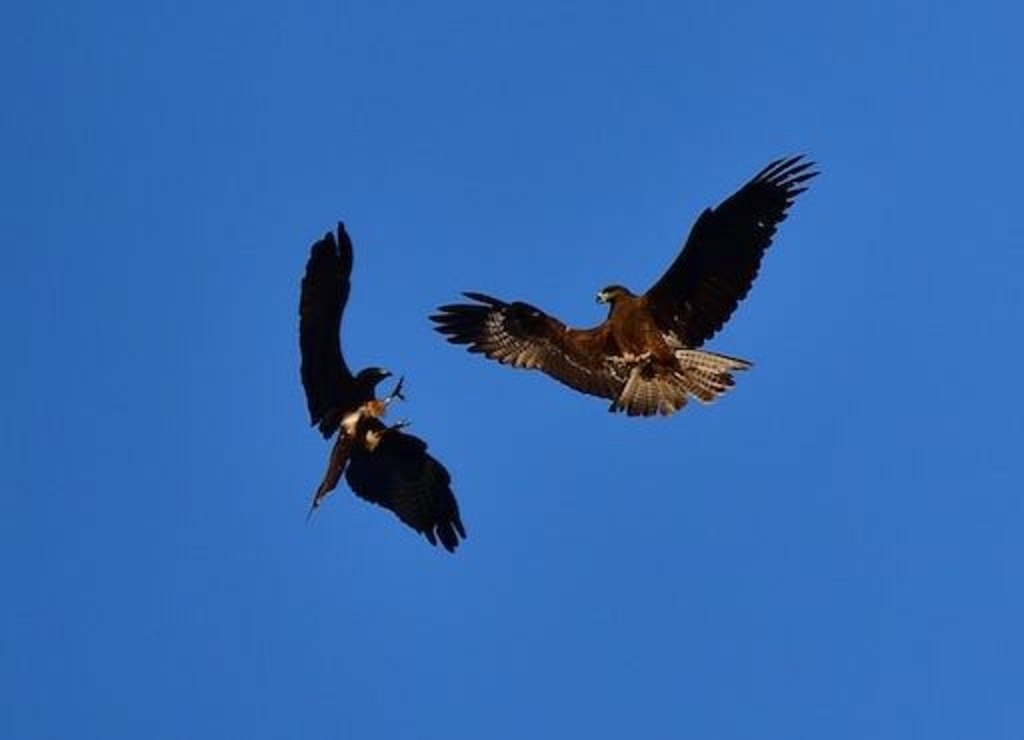
How do Eagles Court
Eagles engage in elaborate courtship rituals to attract their mates. These rituals often involve breathtaking aerial displays, synchronized flights, and gift exchanges.
Male eagles showcase their prowess through acrobatic maneuvers, while females assess their suitors’ strength and agility.
By understanding the fascinating world of eagle courtship, we gain insight into their extraordinary bond and the wonders of nature’s romance.
Overview of Eagle Courtship
Eagle courtship can be characterized by a series of elaborate behaviors and displays, including aerial acrobatics, vocalizations, and gift-giving.
These behaviors are a part of the breeding behavior and courtship rituals of eagles.
During courtship, eagles engage in stunning aerial displays, where they soar to great heights, lock talons, and freefall towards the ground before breaking away at the last moment.
Eagles also use various vocalizations to communicate with their potential mates, including piercing screams and soft whistles.
Additionally, eagles often engage in gift-giving, where they bring sticks, feathers, and other objects to their partner to show their affection.
These courtship behaviors help establish pair bonds between eagles, which can last for several years or even a lifetime.
Monogamy is a common practice among eagles, where they mate with the same partner each breeding season.
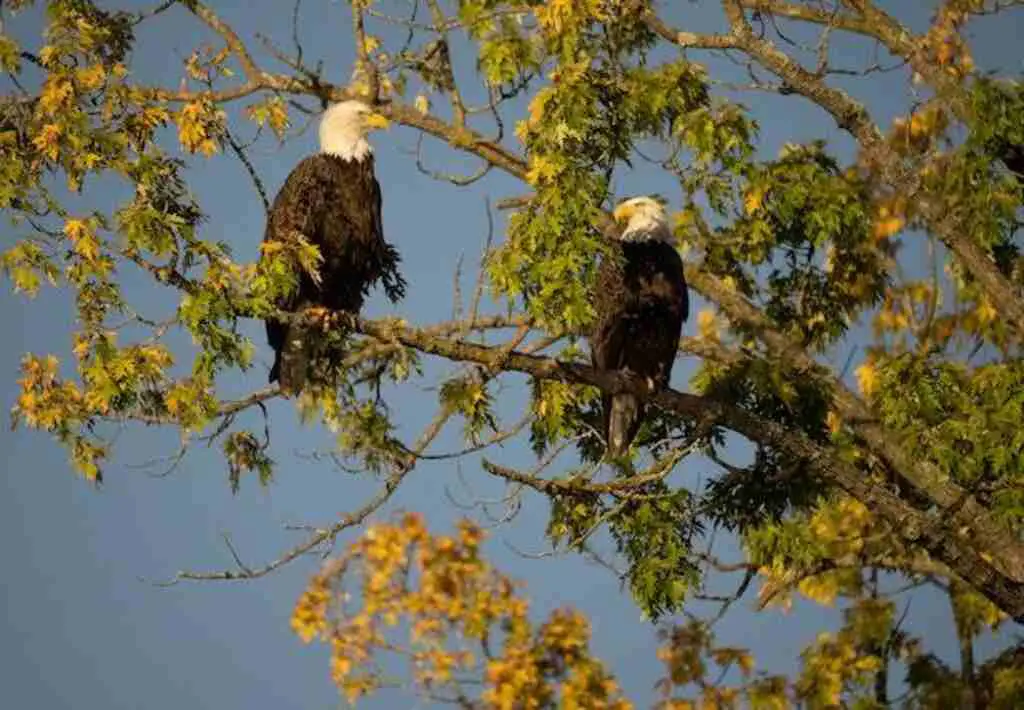
Monogamy in Eagles
Monogamy is a common trait among eagles, and it plays an important role in their courtship and mating behaviors.
Bonding between eagle partners is crucial for successful reproduction, and it involves a range of complex behaviors and rituals.
Once a pair of eagles form a bond, they typically mate for life, remaining faithful to each other and collaborating to raise their young.
Understanding the dynamics of monogamous eagle relationships is essential for conservation efforts and for gaining insights into the social lives of these magnificent birds.
Importance of Bonding
The process of bonding between male and female eagles is crucial for successful courtship and reproduction.
Bonding activities such as preening, nest building, and food sharing help to establish a strong bond between the pair.
Strong bonds are beneficial for eagles as they promote cooperation, communication, and mutual trust.
This is particularly important during the breeding season when the pair must work together to raise their young.
A strong bond between the pair also increases the chances of successful mating, which is essential for the survival of the species.
As eagles are monogamous and mate for life, the process of bonding is a lifelong commitment that requires constant attention and nurturing.
Without a strong bond, the pair may struggle to reproduce and raise their young, ultimately putting the survival of the species at risk.
Lifelong Mating
Symbolism of lifelong commitment in avian species highlights the importance of building and maintaining a strong bond between mates for successful reproduction and survival.
Eagles are one of the many bird species that exhibit this lifelong commitment to their mate.
The natural instincts of eagles drive them to select a mate that is strong, healthy, and able to provide for their offspring.
Once a pair bond is formed, eagles engage in courtship displays that reinforce their bond and ensure successful reproduction.
The selection of a mate is crucial for eagles, as they will remain with their chosen partner for life.
This lifelong commitment allows eagles to build a strong bond that is essential for both their survival and that of their offspring.
Understanding how eagles court and form their lifelong bond provides insight into the importance of mate selection and the natural instincts that drive it.
Moving forward, one can explore how the courtship displays of eagles reinforce their bond and lead to successful reproduction.
Aerial Displays
Aerial displays are a common method used by eagles to court potential mates. These displays involve a series of aerial maneuvers that showcase the eagle’s strength, agility, and fitness.
During these displays, eagles engage in territorial displays, defending their territory and demonstrating their dominance.
Some of the aerial maneuvers that eagles perform during courtship displays include high-speed chases, dives, and rolls.
These displays can be quite elaborate and may last for several minutes or even hours. Eagles use aerial displays to attract mates, and successful displays often result in lifelong bonds between the pair.
Vocalizations also play a significant role in eagle courtship, as eagles use a range of calls and songs to communicate with potential mates.

Vocalizations
Vocalizations are an important aspect of eagle courtship, acting like a symphony of sounds that convey messages and emotions, much like a bird choir.
During courtship, eagles use a variety of vocalizations to communicate with their potential mates.
The male eagle’s vocalizations are typically louder and more complex than the female’s, and they often use them to attract her attention.
One of the most common vocalizations is the ‘screaming’call, which is used to establish territory and attract a mate.
This call is made by both males and females, and it is often heard during aerial displays.
Another vocalization used during courtship is the ‘chittering’call, which is a softer, more intimate sound used to reinforce the bond between a mated pair.
Eagles also use body language and physical displays to communicate during courtship, but their vocalizations play a key role in the courtship process.
Moving on to the next section, eagles often exhibit gift-giving behaviors as part of their courtship rituals.
Gift-giving
While vocalizations are an important aspect of eagle courtship, gift exchange is another significant behavior that eagles engage in during the courting process.
Gift-giving is a behavior observed in many animal species, and in eagles, it involves the presentation of sticks or other nesting materials to potential mates.
This behavior holds evolutionary significance as it demonstrates the male’s ability to provide for and protect the female and their future offspring.
The gift-giving behavior is often accompanied by a series of courtship displays, including aerial acrobatics and synchronized flights, which further demonstrate the male’s fitness and ability to provide for a family.
Gift exchange is a unique behavior observed in eagle courtship and provides insight into the complex social behaviors of these birds of prey.
Moving forward into the next section on nesting and preparation, eagles continue to exhibit fascinating behaviors as they prepare for the breeding season.
Nesting and Preparation
The nesting and preparation behaviors of eagles are critical to their ability to breed and raise offspring successfully in their harsh and unpredictable environments.
The importance of location cannot be overstated, as eagles require stable and secure nesting sites that are often difficult to find.
Once a suitable location is identified, eagles will begin the meticulous process of building their nest, which can take several weeks and involve collecting and arranging materials such as sticks, grasses, and moss.
Eagles use a variety of techniques to construct their nests, including interweaving sticks and branches, shaping the nest with their talons, and lining the interior with soft materials such as feathers and grass.
The level of attention to detail and commitment to the process is truly remarkable, and a testament to the eagles’ dedication to their offspring.
With the nest complete, eagles will spend several weeks preparing for incubation and hatching, which we will explore in the subsequent section.
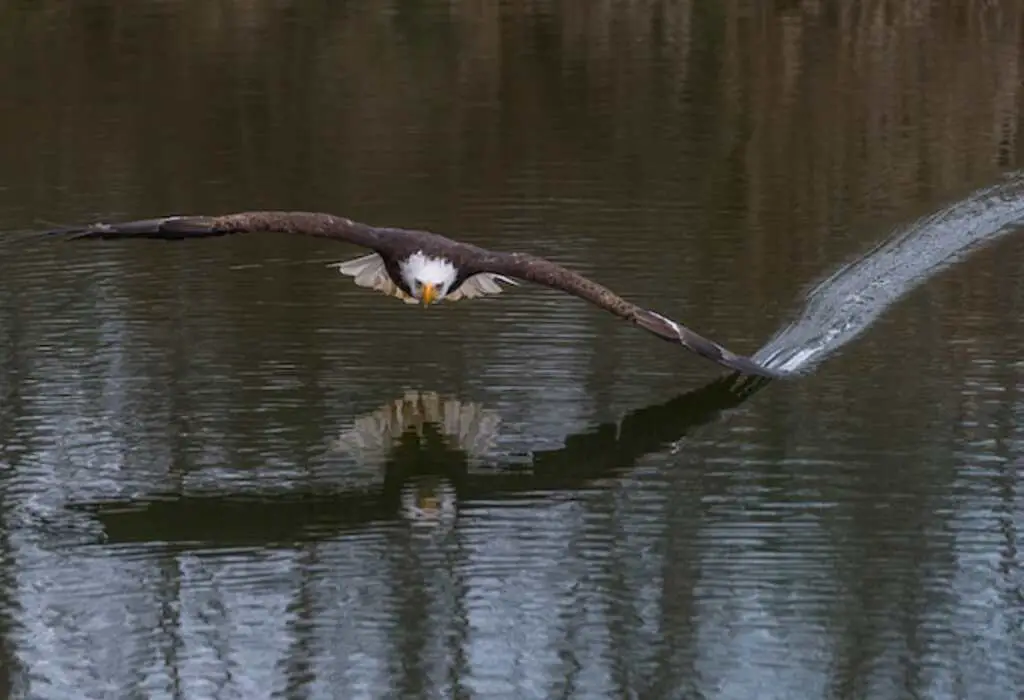
Incubation and Hatching
During incubation and hatching, eagles share incubation duties, with both parents taking turns to keep the eggs warm.
Once the eggs hatch, the parents are responsible for the care of the eaglets, providing them with food and protection.
However, eaglets face a number of challenges, such as sibling rivalry, predation, and harsh weather conditions, which can affect their survival.
Shared incubation duties are a common feature among eagles, where both males and females take turns in incubating their eggs.
This behavior allows for a number of benefits, including a higher likelihood of successful hatching and reduced predation risk.
During incubation, eagles also engage in communication, such as calling and visual displays, which may serve to strengthen the pair bond and coordinate their efforts.
While incubating, eagles must also maintain proper temperature and humidity levels for the developing embryos, which requires careful attention and adjustments.
Once the eggs hatch, the parents continue to share responsibilities in caring for their offspring, including feeding, protection, and teaching essential skills.
Overall, shared incubation duties are a crucial part of eagle breeding behavior, enabling successful reproduction and the continuation of their species.
Hatching and Care of Eaglets
Eagle parents exhibit a remarkable degree of cooperation and division of labor in hatching and caring for their offspring.
The process of hatching eaglets is a delicate one, and the parents have developed unique techniques to ensure the survival of their young.
The female eagle incubates the eggs while the male provides food and protection. Once the eggs hatch, the parents take turns feeding and brooding the eaglets, ensuring that they stay warm and fed.
The eaglets grow rapidly, and by the time they are a few weeks old, they are covered in downy feathers. At this point, the parents begin to teach them survival strategies, such as how to hunt and fly.
This process continues for several months until the eaglets are strong enough to leave the nest and fend for themselves.
Despite the care and attention given by their parents, the eaglets still face many challenges in the wild, such as predators and harsh weather conditions.
Nonetheless, the skills they learn from their parents will help them survive and thrive in their natural habitat.
Challenges Faced by Eaglets
Survival in the wild is a perilous journey for young eaglets, who must navigate treacherous terrain and evade predators in order to thrive. The challenges faced by eaglets are numerous and can be overwhelming.
Here are four examples:
1) Eaglets are vulnerable to attacks from other birds of prey, such as hawks or owls, who see them as competition for food and territory.
2) Eaglets rely on their parents to provide them with food and protection, but if the parents are unable to do so, the eaglets may starve or fall prey to predators.
3) The weather can also be a major challenge for eaglets, as they are susceptible to extreme heat, cold, and storms.
4) Finally, as eaglets grow and begin to explore their surroundings, they may accidentally fall from their nests or get stuck in precarious positions, putting their lives in danger.
Despite these challenges, eaglet survival rates are relatively high thanks to the diligent care of their parents. The next section will explore the vital role that parental care and feeding play in the development of young eaglets.
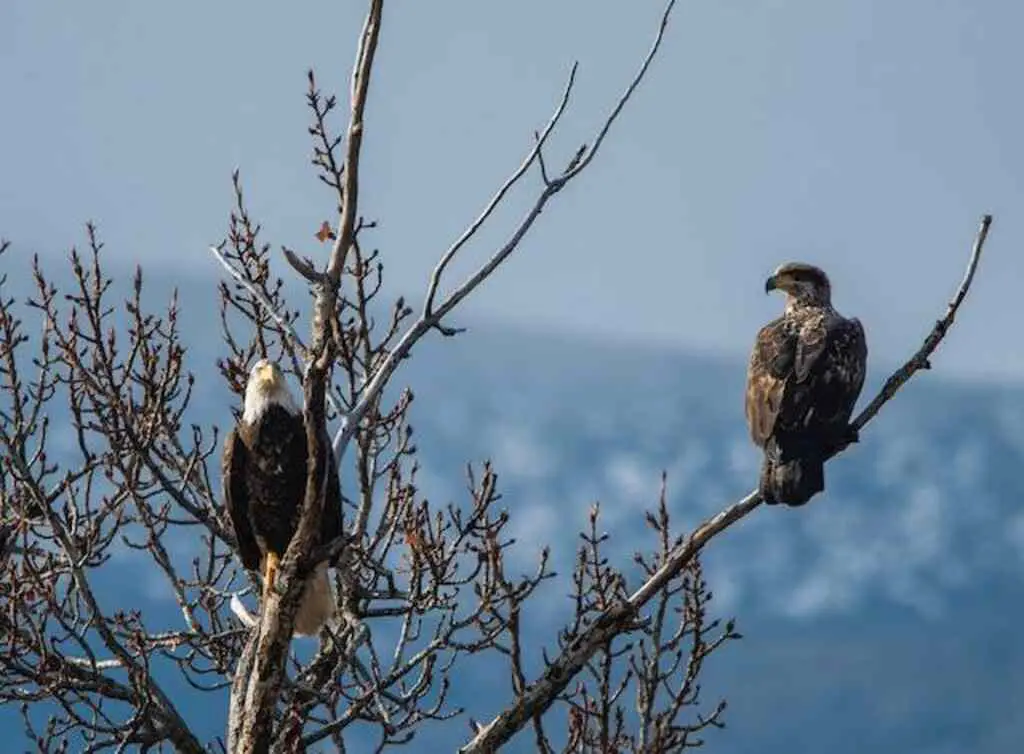
Parental Care and Feeding
Nurturing their young through regurgitation and attentive care, eagles demonstrate a remarkable commitment to ensuring the survival and growth of their offspring.
Feeding habits and parenting skills are critical factors in the successful rearing of eaglets.
Both parent eagles share in the responsibility of feeding their young, with the female typically taking on the majority of the feeding duties during the early stages of development.
The parents tear pieces of meat from prey and then regurgitate the food into the mouths of their eaglets.
This feeding process is not only a practical means of providing nutrition but also strengthens the bond between parent and offspring.
In addition to providing food, eagle parents also demonstrate a high level of attentiveness to their young, ensuring that they are protected from the elements and predators.
This parental care allows eaglets to grow and develop into strong and healthy juvenile eagles.
However, despite the dedication of eagle parents, challenges to eagle courtship can still arise, making it difficult for eagles to find and maintain a mate.
Challenges to Eagle Courtship
Eagle courtship faces several challenges due to various anthropogenic activities.
Habitat destruction, primarily due to deforestation, urbanization, and industrialization, has led to the loss of nesting sites and food sources.
Hunting and poaching for sport, food, and the illegal wildlife trade have also led to a decline in eagle populations.
Climate change is another significant challenge that affects eagle courtship as it alters the timing of breeding cycles and food availability.
These factors pose a threat to the survival and reproduction of eagles and require urgent attention to mitigate their effects.
Habitat Destruction
The gradual disappearance of the natural habitats of eagles due to human activities, such as deforestation and urbanization, has significantly impacted the courtship behaviors of these birds.
Loss of habitat has become one of the biggest challenges that eagles face today, and it is leading to changes in their courtship rituals.
Here are some ways in which the loss of habitat has affected the courtship behaviors of eagles:
1) Reduced nesting sites: As human activities have destroyed forests and other natural habitats, eagles have lost their nesting sites. This has affected their courtship behaviors in terms of selecting a mate and finding a suitable place for nesting.
2) Competition for resources: With fewer nesting sites available, eagles are now competing with other birds and animals for resources. This has led to changes in their courtship behaviors, as they now have to be more aggressive in their pursuit of a mate.
3) Disruption of natural cycles: Human activities have disrupted the natural cycles of eagles, such as their migration patterns and mating seasons. This has affected their courtship behaviors, as they are now forced to adapt to changing conditions.
4) Decline in population: As eagles lose their natural habitats, their populations are declining. This has affected their courtship behaviors, as there are fewer eagles to choose from and mate with.
The loss of habitat has thus become a major factor in the changing courtship behaviors of eagles. These changes are leading to new challenges, such as hunting and poaching, which we will discuss in the subsequent section.
Hunting and Poaching
Hunting and poaching continue to pose a serious threat to the survival of the eagle population, causing concern among wildlife conservationists and the public alike.
Eagles are often hunted for their feathers, which are highly valued in some cultures, or for sport.
Additionally, habitat loss and fragmentation, as discussed in the previous subtopic, have made eagles more vulnerable to hunting and poaching.
To combat this issue, conservation efforts have been implemented, such as stricter laws and regulations, increased law enforcement, and educational programs to raise awareness about the importance of protecting eagles.
However, despite these efforts, eagle populations continue to decline due to illegal hunting and poaching.
It is crucial that we continue to prioritize the conservation of these majestic birds and work towards creating a future where they can thrive and soar freely.
As we move on to the next subtopic about climate change, it is important to note that this issue also has significant impacts on the eagle population.
Climate Change
The impact of climate change on eagle migration patterns has become a growing concern in recent years. As temperatures rise and weather patterns become more unpredictable, these majestic birds of prey are forced to adapt their traditional migratory routes.
Changes in weather patterns can affect the availability of food sources, which can in turn affect breeding cycles and reproductive success rates.
Additionally, rising sea levels and increased storm activity can threaten nesting sites and lead to the loss of crucial habitats.
Scientists and conservationists are closely monitoring these changes to better understand the impact of climate change on eagle populations and to develop strategies to protect these iconic birds.
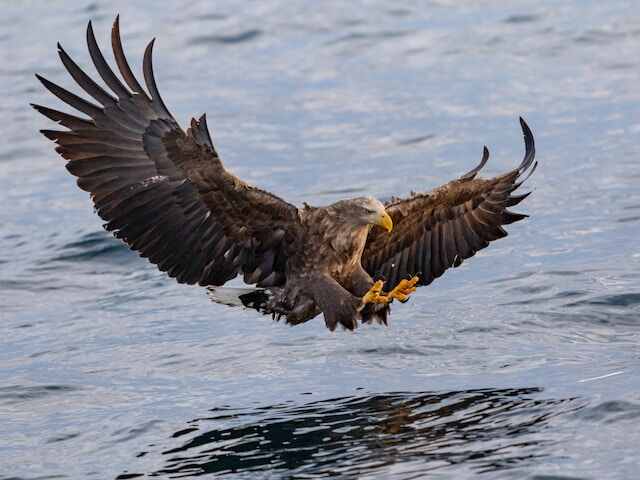
Conservation and Protection Efforts
Efforts to conserve and protect eagles have been likened to a delicate dance, requiring careful coordination and collaboration among scientists, governments, and communities.
Collaborative efforts involve monitoring and managing eagle populations, protecting and restoring habitats, and regulating human activities that may negatively impact eagles.
Community involvement is also crucial, as educating the public and encouraging responsible actions can help minimize human impacts on eagle populations.
The table below highlights some of the key conservation and protection efforts currently in place for eagles in North America.
| Conservation and Protection Efforts | Description |
|---|---|
| Monitoring and Research | Regular monitoring of eagle populations and habitats to track trends and identify threats, as well as research into eagle behavior, ecology, and genetics. |
| Habitat Protection and Restoration | Protecting and restoring eagle habitats, such as shoreline and forest habitats, through conservation easements, land acquisition, and habitat restoration projects. |
| Regulation of Human Activities | Regulating human activities that may negatively impact eagles, such as development, energy production, and hunting, through laws, regulations, and permits. |
| Education and Outreach | Educating the public about eagles and their importance, as well as encouraging responsible actions, such as reducing use of lead ammunition and avoiding disturbance of nesting eagles. |
| International Cooperation | Collaborating with international partners to protect and conserve eagle populations throughout their range, including working with Canada and Mexico to monitor and manage shared populations. |
Through these efforts, eagles have made a remarkable recovery since the 1970s, when populations were decimated by habitat loss, hunting, and pesticide use. However, continued collaboration and community involvement are necessary to ensure the long-term survival of these majestic birds.
Frequently Asked Questions
How long do eagles typically court before mating?
Eagles engage in elaborate courtship rituals and mating behaviors, with the male performing aerial displays and providing gifts to the female. The length of courtship varies but can last from a few days to several weeks, depending on the species.
Do eagles ever cheat on their partners?
Eagle monogamy is a well-known social behavior among the species. While eagles are generally monogamous, there have been rare instances of infidelity. However, these occurrences are not common and do not affect the overall monogamous nature of the species.
How do eagles choose their nesting sites?
Eagle nesting preferences are influenced by habitat selection. A study showed that 85% of bald eagle nests were located within 200 meters of water. Factors such as tree cover and availability of prey also play a role in their choice of nesting site.
Do both male and female eagles take turns incubating the eggs?
Male and female eagles have different roles in incubating eggs, with females typically taking the lead. Nesting habits vary based on factors such as climate and available resources. Understanding these behaviors can aid in conservation efforts for these majestic birds.
How do eagles teach their young to hunt and fly?
Eagles teach their young to hunt and fly through various teaching methods, such as modeling, reinforcement, and practice. These survival skills are crucial for the young eagles’ independence and success in the wild.
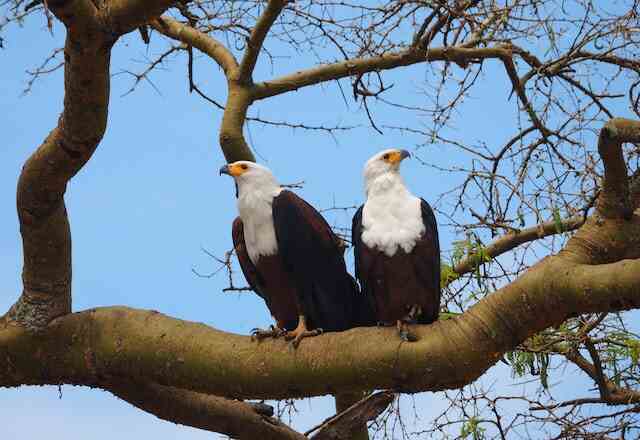
Conclusion
Eagle courtship is a fascinating and complex process that involves various behaviors and strategies. Monogamy is a common trait in eagles, and they often engage in aerial displays and vocalizations to attract and communicate with their mate.
Gift-giving is another notable aspect of eagle courtship, as males often present their partners with sticks and other materials for nest building.
Incubation and hatching are critical stages in eagle courtship, and both parents play a crucial role in caring for the eggs and chicks.
The female typically incubates the eggs, while the male provides food and protection. Once the chicks hatch, both parents participate in feeding and raising them until they are ready to leave the nest.
Despite the many challenges that eagles face, including habitat loss and human disturbances, conservation and protection efforts have helped to ensure their survival.
As such, it is essential to continue these efforts and raise awareness about the importance of eagle conservation.
By understanding the intricacies of eagle courtship and its critical role in the ecosystem, we can better appreciate and protect these magnificent birds of prey.

